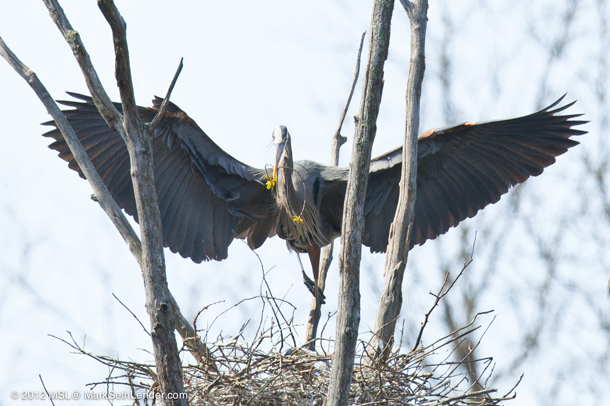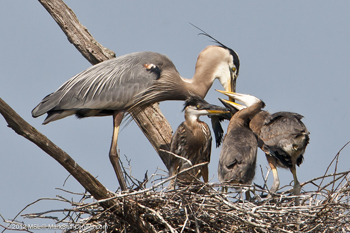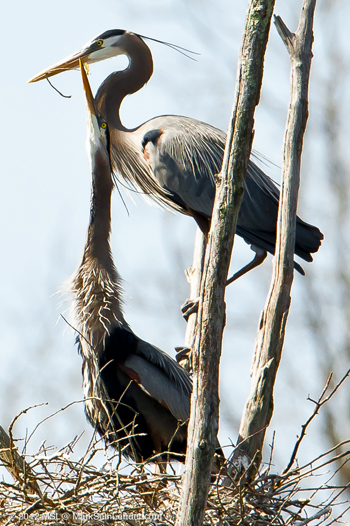Great Blue Heron
Air Date: Week of September 7, 2012
 |
Beaver ponds provide the perfect habitat for Great Blue Herons. The birds make their nests in trees that drowned after beavers dammed streams. Mark Seth Lender reports.
Transcript
CURWOOD: Great Blue Heron rookeries are frequently found in beaver ponds. The trees that drown as a result of the beaver’s enterprise provide perfect nest sites, but only wide, deep ponds that provide safety and separation from shore will do, and these are increasingly uncommon.

They grab her bill, and eventually she disgorges into the nest or right down the throat of one of the chicks. At this age it's usually into the nest so they all can eat. (Photo: Mark Seth Lender)
Writer Mark Seth Lender has spent years searching for a heron rookery—and eventually he found one, just off the Connecticut River, with more than a dozen nests and many Great Blue Herons.
LENDER: The dead oaks spread against the sky like mouths: lips thin as a spindle, grey as their own demise. Dry and cracked and begging for rain though they stand in a pond of water, thirsty though they have drowned. And it is not rain that will come to them, that will purpose this long last stand of their being. Although, like rain, it will come from the clouds, and the color of clouds.
[THE SOUNDS OF GREAT BLUE HERONS]

(Photo: Mark Seth Lender)
In the still air, in guttural blue plumage swirling and shuddering in grey come whispering, rolling like fog, Great Blue Herons! And they glide and glide then pull up straight, waving wide, grey-blue arms, and all in slow motion. Then grasp the thin dead branches, wingtips spread broad as a balance bar, the tightrope quavering in their light and thin-legged touch.
And do not settle but stand tall now in salutation, bright bills upraised… each toward the other, mouths open like branches, necks reaching, Great Blue Herons, lovers never touching as if yearning like a thirst never quenched except in the liquid of the eyes. For the Herons have no water, but neither have they brought fire. And in their mouths they bring only branches, to be woven like baskets, to hold and caress the source of themselves. Oval. Perfect. In the shape of the world before it was born and blue as a pale blue sky.
Patient and practiced, now until the shell breaks open, it will open like a flower to breathe and unfold the feathers like petals, Great Blue Heron emerging small and imperfect to become, the only real and perfect mirror of the self.

(Photo: Mark Seth Lender)
And so continue, until in time, all this is taken and Great Blue Herons pass from this place like a whisper in thin, in blue, in air.
[MUSIC: Clare Connors “Flight Of The Heron” from Heartlight (Heartlight Creations 2005)]
CURWOOD: Mark Seth Lender is the author of Salt Marsh Diary—A Year on the Connecticut Coast. To see photos of the herons, swoop over to our website, LOE dot org.
Living on Earth wants to hear from you!
Living on Earth
62 Calef Highway, Suite 212
Lee, NH 03861
Telephone: 617-287-4121
E-mail: comments@loe.org
Newsletter [Click here]
Donate to Living on Earth!
Living on Earth is an independent media program and relies entirely on contributions from listeners and institutions supporting public service. Please donate now to preserve an independent environmental voice.
NewsletterLiving on Earth offers a weekly delivery of the show's rundown to your mailbox. Sign up for our newsletter today!
 Sailors For The Sea: Be the change you want to sea.
Sailors For The Sea: Be the change you want to sea.
 The Grantham Foundation for the Protection of the Environment: Committed to protecting and improving the health of the global environment.
The Grantham Foundation for the Protection of the Environment: Committed to protecting and improving the health of the global environment.
 Contribute to Living on Earth and receive, as our gift to you, an archival print of one of Mark Seth Lender's extraordinary wildlife photographs. Follow the link to see Mark's current collection of photographs.
Contribute to Living on Earth and receive, as our gift to you, an archival print of one of Mark Seth Lender's extraordinary wildlife photographs. Follow the link to see Mark's current collection of photographs.
 Buy a signed copy of Mark Seth Lender's book Smeagull the Seagull & support Living on Earth
Buy a signed copy of Mark Seth Lender's book Smeagull the Seagull & support Living on Earth

